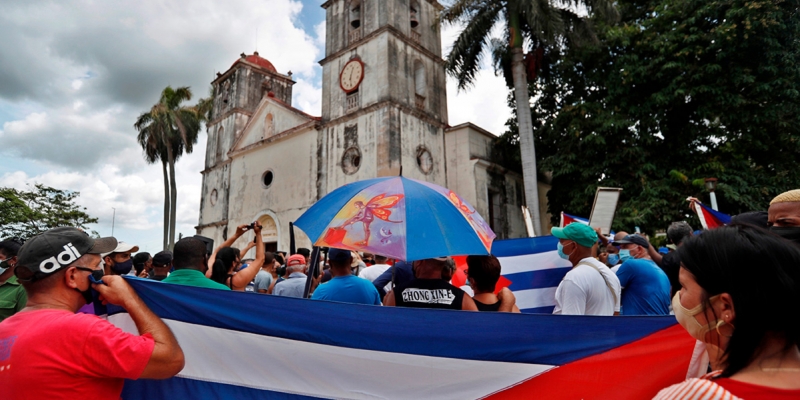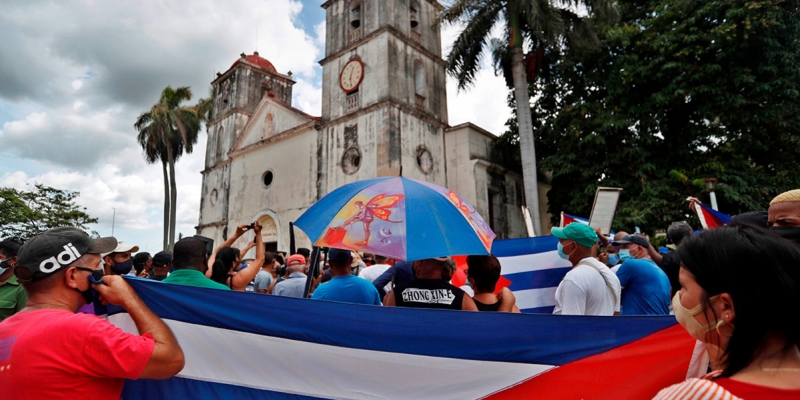Andthe main reason was the decline of the economy, inflation, a shortage of medicines and other essential goods On Sunday, numerous protests were held in several cities of Cuba. The country’s authorities accused the United States of inciting the demonstrators, admitting, however, that the Cubans have reasons for discontent

How Cubans remembered the protests
Over the weekend, the streets of several Cuban cities were filled with protesters with anti-government slogans, in some places it came to clashes with the police.
The first city where the protests began was San Antonio de los Banos with a population of 46 thousand people, located south of Havana, The Financial Times said. In addition, anti-government rallies were held in at least eight cities during Sunday, including in Palma Soriano, Matanzas and in the Cuban capital. Hundreds of people took to the streets in each of them.The most popular slogans were “Down with the dictatorship”, “Freedom”, “Homeland and life”(a reinterpreted slogan of the Cuban revolution “Homeland or death”), according to The Guardian and El Pais. According to the latter,thousands of people took part in the actions. The slogans “Freedom” and “Down with the dictatorship”were replicated on social networks, writes El Pais.
The police used pepper spray and batons in a few cases, but there was no mass violence; at the same time, Internet outages were reported on the island.
Cuban President Miguel Diaz-Canel visited San Antonio de los Banos on Sunday, and then made an urgent televised address. In it, he accused the United States of inciting protests, but admitted that some Cubans may have reasons for discontent. «[There are people who are] dissatisfied with the situation in which they live, ” he said (quoted by RIA Novosti). The Head of State called on supporters of the authorities to also take to the streets. “We are ready to give our lives. They needstep over our dead bodies if they want to face the revolution. We are ready for anything and we will fight in the streets, ” threatened Diaz-Canel, who has been heading the Communist Party of Cuba since April this year and replaced Raul Castro in this post, which marked the end of the rule of the Castro brothers. In Havana, his call was heard & mdash; on Sunday, an action in support of the government was held there. “We came out to defend our gains,” one of the participants of the rally told The Guardian.
The current protests, as well as the situation in the Cuban economy, reminded many analysts of the period following the collapse of the USSR, when Moscow stopped providing generous financial support to the country. In 1994, thousands of protest marches were constantly held on the island, after which one of the mass waves of emigration to the United States began.
What could have provoked the speeches
In San Antonio de los Banos, protesters interviewed by The Financial Times said they were tired of the communist regime, of shops where everything is sold for dollars, of restrictions due to the pandemic and interruptions in the supply of even essential goods. “I’m here because of hunger, because there are no medicines, because the electricity is cut off, because there is not enough of everything,” the Guardian quotes a 40-year-old participant of the demonstration.
“There is very little objective information on the situation so far. It is hardly possible to talk about a specific instigator, rather it is spontaneous protests against the power outage and restrictive measures in the pandemic, ” commented Andrey Pyatakov, senior researcher at the Institute of Latin America of the Russian Academy of Sciences.Non-governmental organizations in Cuba are in an underground situation, they have not yet shown themselves in any way, he continues. “The effect of lifting the taboo on protests has worked, it accidentally broke out in one place, social networks picked up and spread information about the protests, this became the reason for actions in other places,” Pyatakov suggested.
“The protests started spontaneously in small towns as a response to the economic and health situation and reached Havana on Sunday afternoon. There have already been precedents in recent months— there was a protest by artists («The San Isidro Movement» and & laquo;Groups on November 27 & raquo;)», — said the expert of the club«Valdai & raquo; Andres Serbin, executive director of the Regional Coordination Center for Economic and Social Research (CRIES), based in Nicaragua.
“The San Isidro movement” in 2018 was created by several Cuban musicians, journalists and scientists protesting against censorship in the field of culture. In November last year, they held a protest, barricading themselves in a house in the San Isidro district of Havana and demanding the release of one of the detained members of the group. A week later, the police stormed the building, detaining everyone who was there. After that, another protest rally was held near the building of the Ministry of Culture. The President of Cuba also accused the participants of the “San Isidro Movement” of having ties with the United States.
The key factors of discontent are the rise in food prices and its shortage, the power outage, the lack of medical supplies due to the economic crisis and the tourist downturn, the slowness of economic reforms, lists Serbin. The hopes that the normalization of relations will begin under the new US President Joe Biden, as it was under Barack Obama, have not come true, the expert noted.
Video
How the US responded to the protests
Solidarity actions were held in Miami, where a large Cuban diaspora lives. Republican Governor Ron De Santis wrote on Twitter that Florida supports the people of Cuba, ” who took to the streets against the tyrannical regime in Havana.” The US President’s National Security Adviser, Jake Sullivan, noted that ” the United States supports freedom of expression and assembly throughout Cuba and condemns any violence directed against peaceful protestants.”
What is happening with the Cuban economy
The state of the Cuban economy has recently been strongly influenced by the sanctions imposed by the 45th US President Donald Trump (about 200 new restrictive measures were introduced) and the pandemic. At the end of last year, in particular, Western Union money transfer points were closed in Cuba, which limited the ability of the population to receive financial support from relatives abroad.
This year, the Cuban Government began with the reform of the financial system, abandoning the dual currency system: previously, the Cuban peso and the Cuban convertible peso were used simultaneously. Cuban pesos were used by the inhabitants of the island, and the convertible peso, the value of which was equal to one dollar, was mainly used by enterprises in the tourism sector. During the reform, Cubans could exchange a convertible peso for a regular one at the rate of 1: 24, which actually meant the devaluation of the Cuban currency.
There is a shortage of essential goods in the country, including medicines, writes Reuters. To combat the shortage, the government has opened stores where goods are sold for dollars, but it is extremely difficult to exchange pesos for dollars. As a result, prices have soared, inflation will be at least 500% this year, Pavel Vidal, a former economist at the Cuban Central Bank, told Reuters.
Due to last year’s decision of the authorities to close the entrance to the island for tourists due to the pandemic, the tourism industry, which is one of the most important sources of income of the country, has been seriously affected. Restrictive measures remain in place and now a curfew is in effect in most provinces, entertainment facilities are closed, restaurants and takeaway cafes are open, the Russian embassy in Havana reports.
Cubans and the coronavirus
For quite a long time, few cases of COVID-19 were recorded on the island. But recently, the number of cases has begun to grow. The Ministry of Health reports that on July 11, 6923 new cases of infection and 47 deaths were recorded in the country with a population of 11 million people (the data is provided by the government). Developed in Cubaown vaccine, 15% of the population are vaccinated. The pandemic has created additional difficulties for the healthcare system-there is a shortage of medicines in pharmacies: people stand in queues for hours in the provinces, but it is impossible to meet the hype demand for medicines.
RBC in YouTube Live broadcasts, videos and recordings of broadcasts on our YouTube channel

